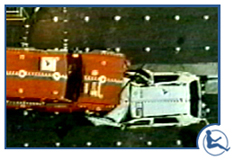 |
|
8016 Lakenheath Way -
Potomac, Maryland 20854 -
Office: 301.299.1800
|
|
|
 |
|
|
 |
VEHICLE MISMATCH: BIG SUVs versus LITTLE CARS
 When a large, heavy SUV or pickup crashes into and penetrates a car's "survival space", the occupants of the car are much more likely to be severely injured or killed. Various mitigation factors are typically not utilized in the design of the either the SUVs to make them less aggressive , nor in cars to make them more crashworthy and protective of their occupants.
A NHTSA study entitled " Striking Vehicle Aggressiveness Factors for Side Impacts " noted that a lower hood profile of light-truck vehicles would reduce the likelihood of severe injury to the car's occupants from 97 percent down to 11 percent.
 
Here are some basic factors that could be considered within a "defective design" context:
Large SUVs and pickups should incorporate more crushable frontal structures to reduce the aggressivity of these huge vehicles when they crash into the front or side of a passenger car or minivan. Many large SUVs and pickups utilize excessively strong, stiff frame rails that act as battering rams, but should inmstead act as deformable "crush zone" frontal structures.
Large SUVs and pickups have front structures that are so tall that they overwhelm and ride over the front and side of the passenger car or minivan. The designs need to ensure a safer, lower match-up of the SUV bumper height with the side sill and door structures of cars and minivans.
Cars and minivans should include much stronger side impact protection structures , such as tubular lateral members at the floorpan and roof level, and multiple door beams and reinforced rocker sill sections, that would significantly stiffen the vehicle side from being crushed inward.
The use of internal baffles and rigid foam within the tubular members of cars and minivans , which can triple the compressive and bending strength of these structural components, for greater side impact protection.
|
 |
|
|
 |
|